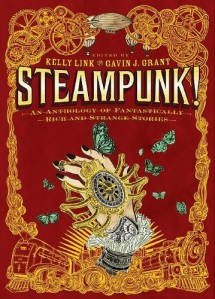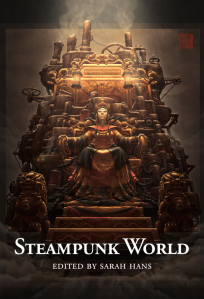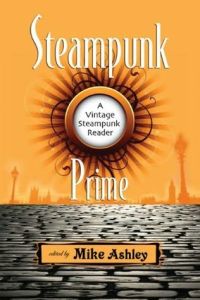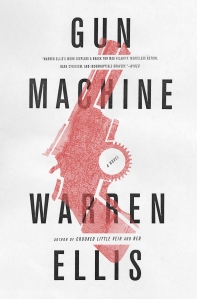
Art by John Coulthart from Steampunk II: Steampunk Reloaded
It was probably about three years ago that I started really thinking critically about steampunk as a genre. At the time I began to formulate some rough ideas about how steampunk could be defined in a way that would be as inclusive as possible yet still specific enough to establish a framework for critical discussion. Originally, I had the idea to write a very thorough piece of literary criticism, analyzing a selection of steampunk novels in order to support my argument. Don’t worry, this is not that essay. Though I would still like to get to it, hopefully sooner rather than later, free time has not been on my side lately, and if I am going to write that piece I would like to do it right. However, since I started writing about steampunk more frequently for Entropic Worlds I found myself wanting to refer to the ideas about steampunk that I have been working through on my own for a while now; of course I can’t, not without providing a page of exposition each time around. My goal here is to offer a critical definition of steampunk, discuss why I prefer it to the definitions I’ve been collecting for the past few years, and offer some anecdotal rather than specific evidence to support it.
Despite the vast body of critical writing on the subject that has appeared in the time since I first became interested, there is still little in the way of a concrete definition that’s useful for critical endeavors. Just In preparing this cursory essay I read or reread over a dozen pieces on the topic, pulled from various anthologies, sources around the web, and the pages of Steampunk Magazine
Unquestionably, the most meticulous and comprehensive attempt to define the genre has been undertaken by Ph.D. Mike Perschon, who goes by the pseudonym the Steampunk Scholar. An overview of his ideas on the topic can be found here on his blog. The premise of his thesis is that steampunk is an aesthetic rather than a genre and that the aesthetic is defined by three interacting elements: technofantasy, retrofuturism, and neo-victorianism. Perschon’s work as one of the pioneering scholars of Steampunk is commendable. He is easily one of the most well-read figures in the community and his blog is packed full of resources for newcomers and aficionados alike. However, I have never felt completely comfortable with his stance on the topic and I have been able to boil that down to three specific complaints.

Issue #3 of Steampunk Magazine
My first issue is perhaps a semantic one, but one that I feel carries substantial weight. The concept that steampunk is an aesthetic rather than a genre is a misconception that stems from a misuse of both terms. The definitions of genre and aesthetic have been used rather casually and sometimes interchangeably for years. This, of course, only matters when it does. Science fiction author Samuel Delany presented a compelling argument for the difference in his fantastic essay “About 5,750 Words.” This quick summary that I’m about to provide hardly does it justice and I strongly recommend reading it for yourself. He argues that there are essentially three aesthetic styles of writing in fiction, each defined by a unique level of subjunctivity. Naturalistic fiction arranges words that create images that “could have happened,” fantasy fiction creates images that “could not have happened,” while science fiction creates images that “have not happened.” To claim, as Perschon does, that steampunk is not a genre because it overlaps with all three narrative modes without having recurring narrative strands of its own is something of a fallacy from this perspective. In fact steampunk, along with other recognizable genres such as horror and mystery, does have a set of unique narrative elements that can be expressed through each of the aesthetic modes of naturalistic fiction, fantasy, and science fiction.
Second, while Perschon’s characteristics of steampunk fiction appear to be quite specific, they become a bit more wishy-washy when scrutinized. A work that contains all three of these elements would almost certainly be steampunk, yet it is easy to imagine a piece of fiction that while containing one or more of these elements, is not steampunk. The first example that comes to mind is Alfred Bester’s The Stars, My Destination which, despite featuring a group of future aristocrats who have adopted a neo-Victorian lifestyle, is really a dystopian space opera adventure because the neo-Victorianism represents a plausible trajectory of society rather than an anachronism. Perschon’s set of constraints seems to be effective at determining how steampunk something is, though not necessarily how good a work of steampunk is, which brings me to my final objection.
 What I am looking for is a definition of steampunk that allows critics to evaluate how effective, original, or progressive a given example of steampunk is, even if the element is a minor one within the broader scope of the piece. I am personally more interested in reading a book that does steampunk well, even if it only does it a little bit, versus a steampunk book that is unoriginal and uninteresting, regardless of how filled it is with dirigibles, aether, and parasols.
What I am looking for is a definition of steampunk that allows critics to evaluate how effective, original, or progressive a given example of steampunk is, even if the element is a minor one within the broader scope of the piece. I am personally more interested in reading a book that does steampunk well, even if it only does it a little bit, versus a steampunk book that is unoriginal and uninteresting, regardless of how filled it is with dirigibles, aether, and parasols.
Perschon isn’t the only scholar to define steampunk as an aesthetic. In their introduction to the 2010 anthology, Steampunk Reloaded, Ann and Jeff Vandermeer refer to steampunk as “an aesthetic toolbox useful for a range of approaches.” Many other pieces on the topic eschew categorization entirely in favor of a descriptive approach that almost seems mystical in its effort to conjure the indescribable quality of steampunk. To this end, the Catastrophone Orchestra writes: “[steampunks] are archaeologists of the present, reanimating a hallucinatory history.” The approaches to definition are varied and the task is a daunting one.
So, where does that leave us then? I have never been able to shake my belief that there is something more solid to the foundation of steampunk, at least as a literary pursuit. The flashy tropes that characterize the genre are not merely aesthetic veneers, but are a language used to explore some more fundamental cultural concern, just as werewolves, vampires, and zombies are a language used to explore our culture’s repressed fears. I believe that steampunk is a genre of literature, and furthermore, that it can be identified by three specific narrative elements: a quality of anachronism, the invention or introduction of a new or repurposed technology, and a conflict over the control or application of that technology. If you take these elements at their most rigid face value, you wind up describing a novel like Sterling and Gibson’s The Difference Engine. This is probably appropriate given that that novel is one of the most universally accepted examples of the genre, however, given a certain degree of flexibility, I believe that the definition I have laid out can easily transcend the narrow focus of Victorian alternate history grounded in the imperialist/industrial complex of the era. What follows is a more detailed discussion of the three narrative elements of steampunk.
In order to fully appreciate the concept of anachronism in steampunk literature one needs to begin to think beyond the limiting notions of neo-Victorianism or retrofuturism. In fact, even in steampunk novels that strongly orient toward these characteristics, anachronism may derive from a different place altogether. One of the most striking examples is found in K.W. Jeter’s Infernal Devices. Although the novel is set in a fictional Victorian England and utilizes fantastical inventions and clockwork automata, it is in the dialog of the character of Scape, a man who has seen the future by means of a pseudoscientific device, that Jeter creates much of his anachronistic tension. Scape’s affectedly modern speech pervades the novel creating a contrast between our expectations of the historical setting and our own knowledge of the future. Social conventions and organization are used to evoke a quality of anachronism; frequently it is the intrusion of a full scale industrial revolution on the Victorian social structure, rather than the retro-futuristic technology that was responsible for it, that creates the anachronism. In Ekaterina Sedia’s Alchemy of Stone antiquated medieval relics, such as gargoyles, literally interact with a low-tech mining industry and a techno-fantastic automata creating a landscape that exists as a cross-section of centuries of technological innovation struggling to exist at the same moment. Though anachronism can be located in many places within the context of a given narrative, its implications are significant in steampunk and its effect is to create a setting that is not defined by the standard linear trajectory of historical progress.
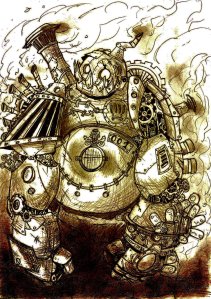
A steampunk golem by Viejuno
Regardless of where the anachronism is located, steampunk features some innovation or repurposing of technology. However, it serves no practical purpose to define technology through a narrow lens. Technology in steampunk specifically signifies a transformation of the status quo, however, where traditional speculative fiction often looks at technological innovation in order to speculate on the consequences of a specific discovery, steampunk is more concerned with the idea of technological change on its own. Consequently, steampunk technology may come in the form of mechanical computers, lighter-than-air ships, or other retrofuturistic concepts grounded in hard science or engineering, but it may also be far more fantastical. Steampunk has the unique ability to blur the lines between science and fantasy, yet the significance of innovation and discovery remains the same. In a fictional world in which aether is a reality, then a fuel source derived from aether is technology according to the scientific laws of that world. Even magic can play the role of technology in steampunk given that it is grounded in some technological source, such as language, which is technology after all. Thus the golem, a homunculus brought to life through sacred words, is essentially congruous to an automaton brought to life through a computer program. Despite the fetishization of particular industrial aesthetics that seem to characterize steampunk, it is a preoccupation with the impact that technological change has on society that informs steampunk as a genre.
What we have so far is a setting that is not defined by historical or logical chronology into which a status changing technological innovation has been introduced. The way that steampunk explores this often cataclysmic shift in the status quo is through a conflict over control or ownership over the technology. This is often represented through a large-scale conflict between competing social or political interests. The conflict can also be very personal or even internal, as is the case in Jeff Vandermeer’s short story “Fixing Hanover.” This story flips the traditional expectations of the genre by depicting an inventor who struggles to relinquish his ownership over the deadly inventions for which he is responsible. The conflict may also play out against traditional domestic relationships as well. In a lurid take on 19th century gender expectations, Margo Lanagan’s “Machine Maid” tells the story of an oppressed woman who subverts the device that she discovers to be an agent of her oppression into that of her liberation.
The narrative elements of technological innovation and conflict over control of that innovation are not new. They have been present in science fiction and naturalistic fiction for decades, especially in the dystopian genre. Where steampunk separates in a meaningful way is by locating technological change outside of either a recognizable history or a projected future. This difference is what makes steampunk such an important genre right now. Science fiction that deals primarily with new technology within a standard chronological tradition faces two significant challenges that steampunk manages to overcome. One is that of longevity. Regardless of an author’s intention, speculative explorations of technological innovation are often interpreted as prophecy. This has two possible consequences: either the prophecy comes true or it doesn’t. In the case of the former, any of the work’s social relevance is often ignored for the novelty of the prophecy itself; in the case of the latter, the work is quickly dated and then subsequently ignored outright by future readers. Steampunk’s chances for longevity and continued relevance are great because the technology they depict can never date.
A more significant challenge facing technological fiction, especially fiction that presents a far future or an extreme dystopia, is the tendency for readers to distance themselves from the social implications of the literature because they are too far removed either culturally, or chronologically, despite the connections the author may have intended to make to contemporary life. Steampunk has a unique opportunity to reflect powerfully on contemporary culture and society specifically because it never purports to resemble it in any way.
It is no mistake that steampunk has reached critical mass during a period when technological innovation is occurring at such a rapid rate that, as individuals, we literally cannot slow down long enough to consider the implications. Steampunk is often cited as a reaction against the sterile and mass produced technological culture of the digital age. This strikes me as a very reductive explanation; even a superficial glance at my twitter feed will tell you that the number of steampunks whose iPhones constitute an extra appendage is as great as in any other subculture, possibly greater. Furthermore, I don’t believe that the subculture could have possibly grown to the size it has with the level of coordination and interaction that it demonstrates if it weren’t for social media and the associated software and hardware. Steampunk doesn’t exist to pass judgments on technology, but to attempt to explore the implications of modern “progress” through a disinterested lens.
 So what, then, of politics and values in steampunk? Cherie Priest (author of the Clockwork Century series) tackled the question of defining steampunk in her essay “Steampunk: What it is, why I came to like it, and why I think it’ll stick around.” It’s probably the most exuberant and infectious piece out there and the most memorable line in the essay is “It is lots of fun. If it isn’t lots of fun, you’re doing it wrong.” This seems to imply that steampunk’s value is primarily escapist. I don’t mean to put words into Priest’s mouth, I actually think she made this statement in order to highlight the idea that steampunk is an original, creative, endeavor that is at its best with passionate engagement from fans, readers, and writers. Furthermore, her work in the genre is hardly escapist schlock, it is fiercely intelligent and she often focuses on marginalized characters whose stories have broad socio-political implications.
So what, then, of politics and values in steampunk? Cherie Priest (author of the Clockwork Century series) tackled the question of defining steampunk in her essay “Steampunk: What it is, why I came to like it, and why I think it’ll stick around.” It’s probably the most exuberant and infectious piece out there and the most memorable line in the essay is “It is lots of fun. If it isn’t lots of fun, you’re doing it wrong.” This seems to imply that steampunk’s value is primarily escapist. I don’t mean to put words into Priest’s mouth, I actually think she made this statement in order to highlight the idea that steampunk is an original, creative, endeavor that is at its best with passionate engagement from fans, readers, and writers. Furthermore, her work in the genre is hardly escapist schlock, it is fiercely intelligent and she often focuses on marginalized characters whose stories have broad socio-political implications.
However, the idea that steampunk should be “fun” is a curious one. Fun as opposed to what? Boring? Tedious? Scholarly? Surely it can’t mean in opposition to political? Intellectual? Didactic? Needless to say, “fun” is extremely subjective, any of the three qualities I just listed can be incredibly fun given the right treatment. I’ll admit that I like my steampunk political, in fact, I don’t mind a healthy dose of politics in anything I read. Personally, I find radical politics and socio-political subversion every bit as exhilarating as airship battle. According to the model of steampunk I’ve laid out, the genre need not be political; it must, however, be social. Given the setting and elements of steampunk literature, social effects and interactions are necessary. Like any fiction writing, the story will be more compelling the more the social environment of the world has been mapped out. As readers, this is where we should be asking questions about steampunk. Who are the groups or individuals in conflict over the technological innovation? What interest does each have in controlling the innovation? Should there be a third party with an interest in it, if so who? If not represented directly in the conflict, what impact, if any, will the consequences have on groups like the poor, the working class, minorities, women, LGBT interests? If those groups aren’t directly involved, why not? Is it a logical consequence of the narrative elements or is it neglect on the part of the author? When we begin to treat steampunk with this type of complex social criticism I believe the divisive discussions between escapism and politics will dissipate in favor of a quality discussion of the genre’s social significance.
I don’t claim that the definition that I’ve laid out is universal, nor have I read everything in the genre, but I do believe that examples of steampunk that don’t fit this definition are relatively rare exceptions, or maybe just not steampunk. On one hand, I think it’s important to remember that there are some things that may be pretty universally liked by steampunk fans that aren’t really steampunk, just as many fans of punk proper appreciate the music of Tom Waits and The Velvet Underground, though it would be hard to really classify those artists as punk. On the other hand I believe that we could create some interesting discussions by using this definition, or a similarly specific definition, to look at why something isn’t steampunk, or at least is a different kind of steampunk.
It should also be noted that this model does not apply to many of the steampunk offshoots. Dieselpunk, for instance, doesn’t usually focus on the introduction of new technology. For the most part, works set in this genre, tend to exist in a world where the future has already come and gone. Retrofuturism is arguably more a part of dieselpunk than steampunk because dieselpunk exists in that 1940s art-deco fantasy image of the future. It is concerned with exploring the aftermath of the future; who is thriving? Who has been discarded? What is the state of industry and the environment? But I’m opening up a whole new can of worms so I’ll refrain from going any further, I only mean to illustrate the idea that this model of steampunk is meant to open and inspire discussion, rather than close the topic once and for all.
I have intentionally left two issues absent from this discussion: the future of steampunk given this model and how this model works with steampunk in media other than literature. I have some formative ideas on both and I hope to get to them soon, but that is plenty for today. The next post in the “Steampunk Files” will look at feminism in steampunk short stories so check back in the near future. In the meantime, please share your thoughts in the comments section.
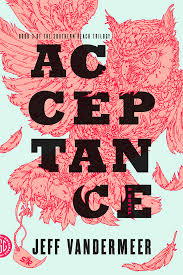 Acceptance: Book 3 of the Southern Reach Trilogy
Acceptance: Book 3 of the Southern Reach Trilogy


 Posted by tvgilbert
Posted by tvgilbert 